CFD Analysis of Solar Greenhouse Thermal and Humidity Environment Considering Soil–Crop–Back Wall Interactions
Abstract
:1. Introduction
2. Materials and Methods
2.1. Experimental Greenhouse
2.2. Data Collection
2.3. Physical Model and Numerical Modeling
2.3.1. Computational Domain and Mesh Generation
2.3.2. Governing Equation
- The gas phase consists of a binary ideal gas mixture of air and water vapor;
- Ignore soil water vapor evaporation and water vapor condensation;
- Ignore the effect of cold air infiltration in the greenhouse.
2.3.3. Radiation Model
2.3.4. Crop Energy Balance Equation
2.4. Fitting Regression Equations
2.5. Boundary Conditions and Model Solving
2.6. Evaluation Index
2.6.1. Model Validation Evaluation Index
2.6.2. Correlation Evaluation Index
3. Results and Discussion
3.1. Analysis of Solar Greenhouse Environment
3.2. Model Validation
3.3. Numerical Simulation under Different Working Conditions
3.3.1. Numerical Simulation of Daytime Insulation Uncovered and Ventilation Window Closed (G1)
3.3.2. Numerical Simulation of Daytime Insulation Uncovered and Ventilation Window Opened (G2)
3.3.3. Numerical Simulation of Nighttime Insulation Put down and Ventilation Window Closed
3.4. Correlation Analysis of Indoor Air Temperature and Relative Humidity with Back Wall and Soil Temperature
4. Conclusions
Author Contributions
Funding
Data Availability Statement
Conflicts of Interest
References
- Choab, N.; Allouhi, A.; El Maakoul, A.; Kousksou, T.; Saadeddine, S.; Jamil, A. Review on greenhouse microclimate and application: Design parameters, thermal modeling and simulation, climate controlling technologies. Sol. Energy 2019, 191, 109–137. [Google Scholar] [CrossRef]
- Zhang, X.; Wang, H.; Zou, Z.; Wang, S. CFD and weighted entropy based simulation and optimisation of Chinese Solar Greenhouse temperature distribution. Biosyst. Eng. 2016, 142, 12–26. [Google Scholar] [CrossRef]
- Abbas, Z.; Yong, L.; Abbas, S.; Chen, D.; Li, Y.; Wang, R. Performance analysis of seasonal soil heat storage system based on numerical simulation and experimental investigation. Renew. Energy 2021, 178, 66–78. [Google Scholar] [CrossRef]
- Li, Y.; Liu, X.; Qi, F.; Wang, L.; Li, T. Numerical investigation of the north wall passive thermal performance for Chinese solar greenhouse. Therm. Sci. 2020, 24, 3465–3476. [Google Scholar] [CrossRef]
- Zhang, X.; Lv, J.; Dawuda, M.M.; Xie, J.; Yu, J.; Gan, Y.; Zhang, J.; Tang, Z.; Li, J. Innovative passive heat-storage walls improve thermal performance and energy efficiency in Chinese solar greenhouses for non-arable lands. Sol. Energy 2019, 190, 561–575. [Google Scholar] [CrossRef]
- Wang, J.; Li, S.; Guo, S.; Ma, C.; Wang, J.; Jin, S. Simulation and optimization of solar greenhouses in Northern Jiangsu Province of China. Energy Build. 2014, 78, 143–152. [Google Scholar] [CrossRef]
- Liu, X.; Li, H.; Li, Y.; Yue, X.; Tian, S.; Li, T. Effect of internal surface structure of the north wall on Chinese solar greenhouse thermal microclimate based on computational fluid dynamics. PLoS ONE 2020, 15, e0231316. [Google Scholar] [CrossRef] [Green Version]
- Fan, Z.; Liu, X.; Yue, X.; Zhang, L.; Xie, X.; Li, Y.; Li, T. Effect of external thermal insulation layer on the Chinese solar greenhouse microclimate. R. Soc. Open Sci. 2021, 8, 211–217. [Google Scholar] [CrossRef]
- Sypka, P.; Kucza, J.; Starzak, R. Assumptions for Fourier-based modelling of diurnal temperature variations in the top soil layer under Istebna spruce stands. Agric. For. Meteorol. 2016, 222, 71–86. [Google Scholar] [CrossRef]
- Roxy, M.S.; Sumithranand, V.B.; Renuka, G. Estimation of soil moisture and its effect on soil thermal characteristics at Astronomical Observatory, Thiruvananthapuram, south Kerala. J. Earth Syst. Sci. 2014, 123, 1793–1807. [Google Scholar] [CrossRef] [Green Version]
- Baille, A.; López, J.C.; Bonachela, S.; Gonzalez-Real, M.M.; Montero, J.I. Night energy balance in a heated low-cost plastic greenhouse. Agric. For. Meteorol. 2006, 137, 107–118. [Google Scholar] [CrossRef]
- Bonachela, S.; Granados, M.R.; López, J.C.; Hernández, J.; Magán, J.J.; Baeza, E.J.; Baille, A. How plastic mulches affect the thermal and radiative microclimate in an unheated low-cost greenhouse. Agric. For. Meteorol. 2012, 152, 65–72. [Google Scholar] [CrossRef]
- Katsoulas, N.; Stanghellini, C. Modelling crop transpiration in greenhouses: Different models for different applications. Agronomy 2019, 9, 392. [Google Scholar] [CrossRef] [Green Version]
- Kichah, A.; Bournet, P.E.; Migeon, C.; Boulard, T. Measurement and CFD simulation of microclimate characteristics and transpiration of an Impatiens pot plant crop in a greenhouse. Biosyst. Eng. 2012, 112, 22–34. [Google Scholar] [CrossRef]
- Boulard, T.; Roy, J.C.; Pouillard, J.B.; Fatnassi, H.; Grisey, A. Modelling of micrometeorology, canopy transpiration and photosynthesis in a closed greenhouse using computational fluid dynamics. Biosyst. Eng. 2017, 158, 110–133. [Google Scholar] [CrossRef]
- Norton, T.; Sun, D.W.; Grant, J.; Fallon, R.; Dodd, V. Applications of computational fluid dynamics (CFD) in the modelling and design of ventilation systems in the agricultural industry: A review. Bioresour. Technol. 2007, 98, 2386–2414. [Google Scholar] [CrossRef]
- Van Hooff, T.; Blocken, B. CFD evaluation of natural ventilation of indoor environments by the concentration decay method: CO2 gas dispersion from a semi-enclosed stadium. Build. Environ. 2013, 61, 1–17. [Google Scholar] [CrossRef]
- Ali, H.B.; Bournet, P.E.; Cannavo, P.; Chantoiseau, E. Using CFD to improve the irrigation strategy for growing ornamental plants inside a greenhouse. Biosyst. Eng. 2019, 186, 130–145. [Google Scholar]
- Li, H.; Ji, D.; Hu, X.; Xie, T.; Song, W.; Tian, S. Comprehensive evaluation of combining CFD simulation and entropy weight to predict natural ventilation strategy in a sliding cover solar greenhouse. Int. J. Agric. Biol. Eng. 2021, 14, 213–221. [Google Scholar] [CrossRef]
- Boulard, T.; Wang, S. Experimental and numerical studies on the heterogeneity of crop transpiration in a plastic tunnel. Comput. Electron. Agric. 2002, 34, 173–190. [Google Scholar] [CrossRef]
- Wilson, J.D. Numerical studies of flow through a windbreak. J. Wind. Eng. Ind. Aerodyn. 1985, 21, 119–154. [Google Scholar] [CrossRef]
- Roy, J.C.; Boulard, T.; Kittas, C.; Wang, S. PA—Precision Agriculture: Convective and ventilation transfers in greenhouses, Part 1: The greenhouse considered as a perfectly stirred tank. Biosyst. Eng. 2002, 83, 1–20. [Google Scholar] [CrossRef] [Green Version]
- Nield, D.A.; Bejan, A. Convection in Porous Media; Springer: New York, NY, USA, 2006; Volume 3. [Google Scholar]
- An, C.H.; Ri, H.J.; Han, T.U.; Kim, S.I.; Ju, U.S. Feasibility of winter cultivation of fruit vegetables in a solar greenhouse in temperate zone; experimental and numerical study. Sol. Energy 2022, 233, 18–30. [Google Scholar] [CrossRef]
- Stanghellini, C. Transpiration of Greenhouse Crops: An Aid to Climate Management; Wageningen University and Research: Wageningen, The Netherlands, 1987. [Google Scholar]
- Baille, M.; Baille, A.; Laury, J.C. Canopy surface resistances to water vapour transfer for nine greenhouse pot plant crops. Sci. Hortic. 1994, 57, 143–155. [Google Scholar] [CrossRef]
- Zhang, G.; Fu, Z.; Yang, M.; Liu, X.; Dong, Y.; Li, X. Nonlinear simulation for coupling modeling of air humidity and vent opening in Chinese solar greenhouse based on CFD. Comput. Electron. Agric. 2019, 162, 337–347. [Google Scholar] [CrossRef]
- Li, H.; Li, Y.; Yue, X.; Liu, X.; Tian, S.; Li, T. Evaluation of airflow pattern and thermal behavior of the arched greenhouses with designed roof ventilation scenarios using CFD simulation. PloS ONE 2020, 15, e0239851. [Google Scholar] [CrossRef]
- Blocken, B.; Stathopoulos, T.; Carmeliet, J. CFD simulation of the atmospheric boundary layer: Wall function problems. Atmos. Environ. 2007, 41, 238–252. [Google Scholar] [CrossRef]
- Shamshiri, R.R.; Jones, J.W.; Thorp, K.R.; Ahmad, D.; Man, H.C.; Taheri, S. Review of optimum temperature, humidity, and vapour pressure deficit for microclimate evaluation and control in greenhouse cultivation of tomato: A review. Int. Agrophys. 2018, 32, 287–302.087. [Google Scholar] [CrossRef]
- Suzuki, M.; Umeda, H.; Matsuo, S.; Kawasaki, Y.; Ahn, D.; Hamamoto, H.; Iwasaki, Y. Effects of relative humidity and nutrient supply on growth and nutrient uptake in greenhouse tomato production. Sci. Hortic. 2015, 187, 44–49. [Google Scholar] [CrossRef] [Green Version]

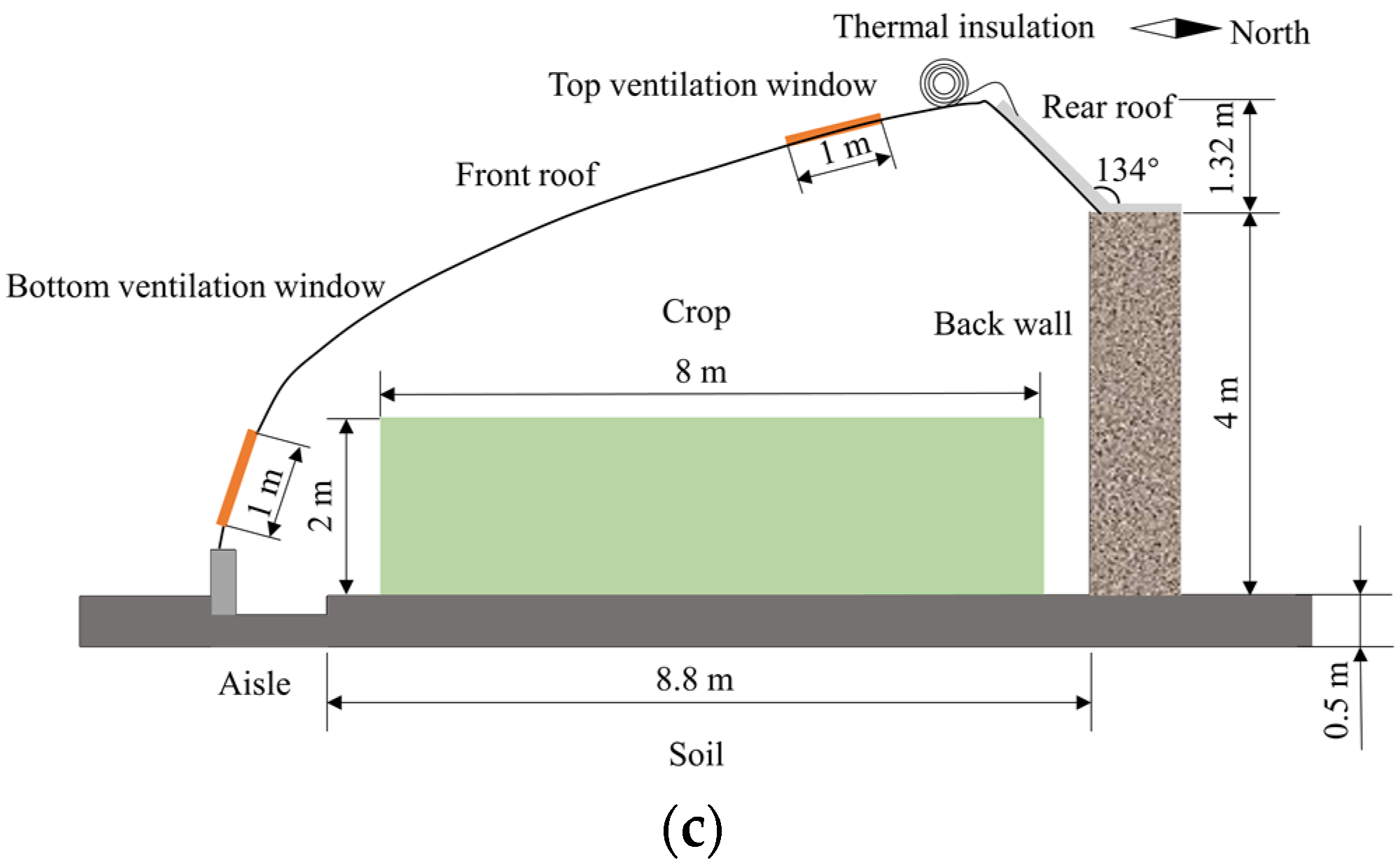

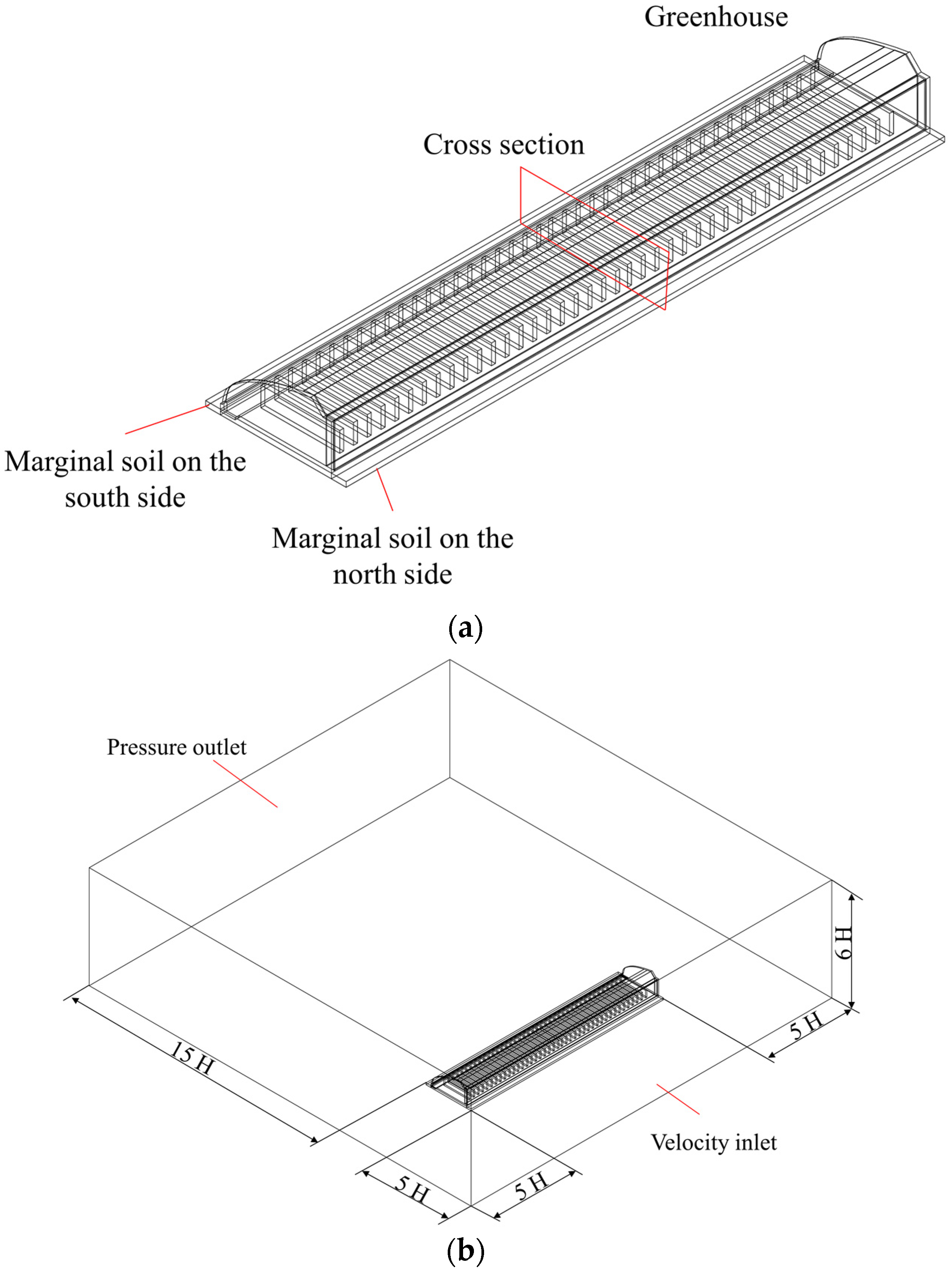

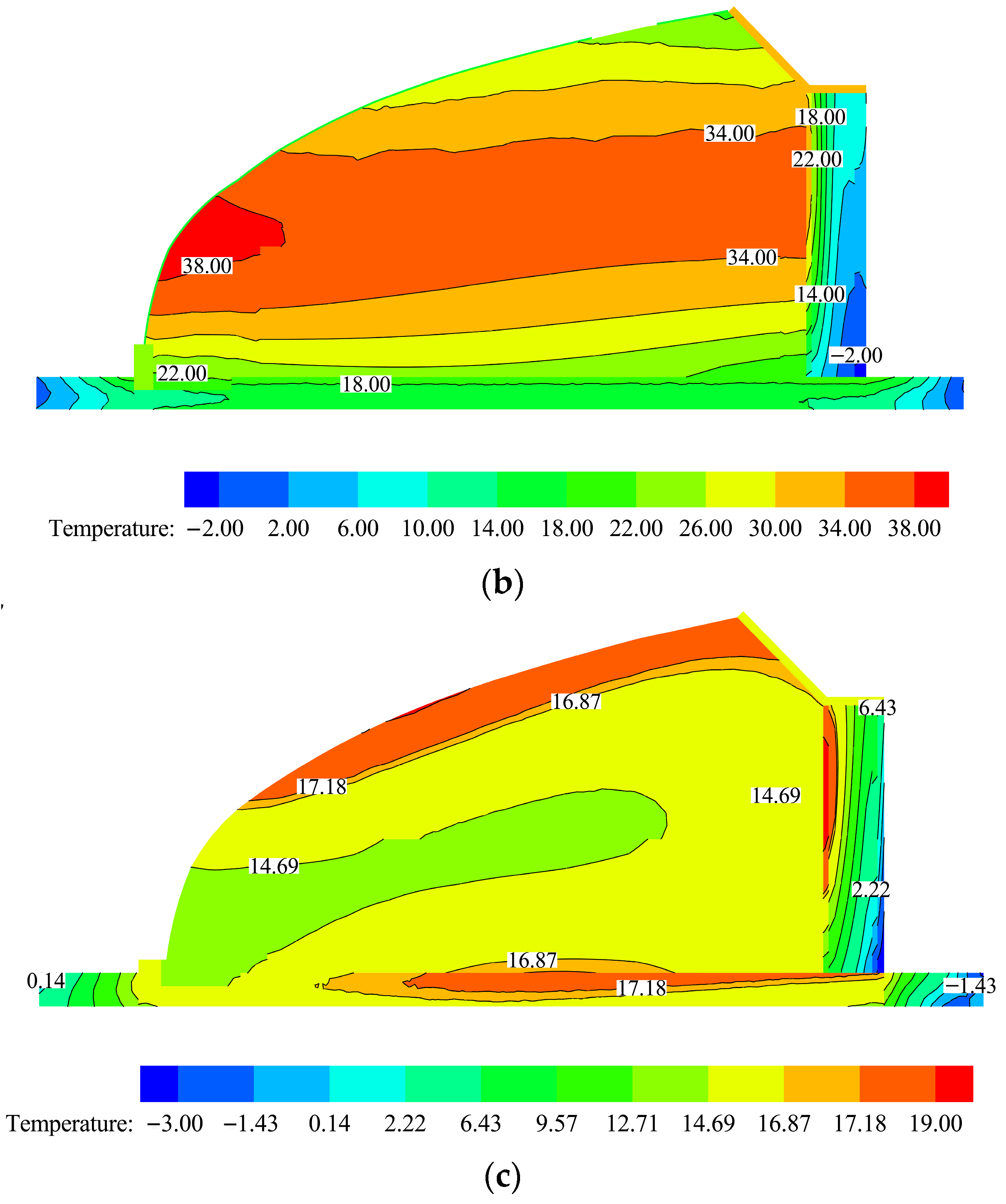
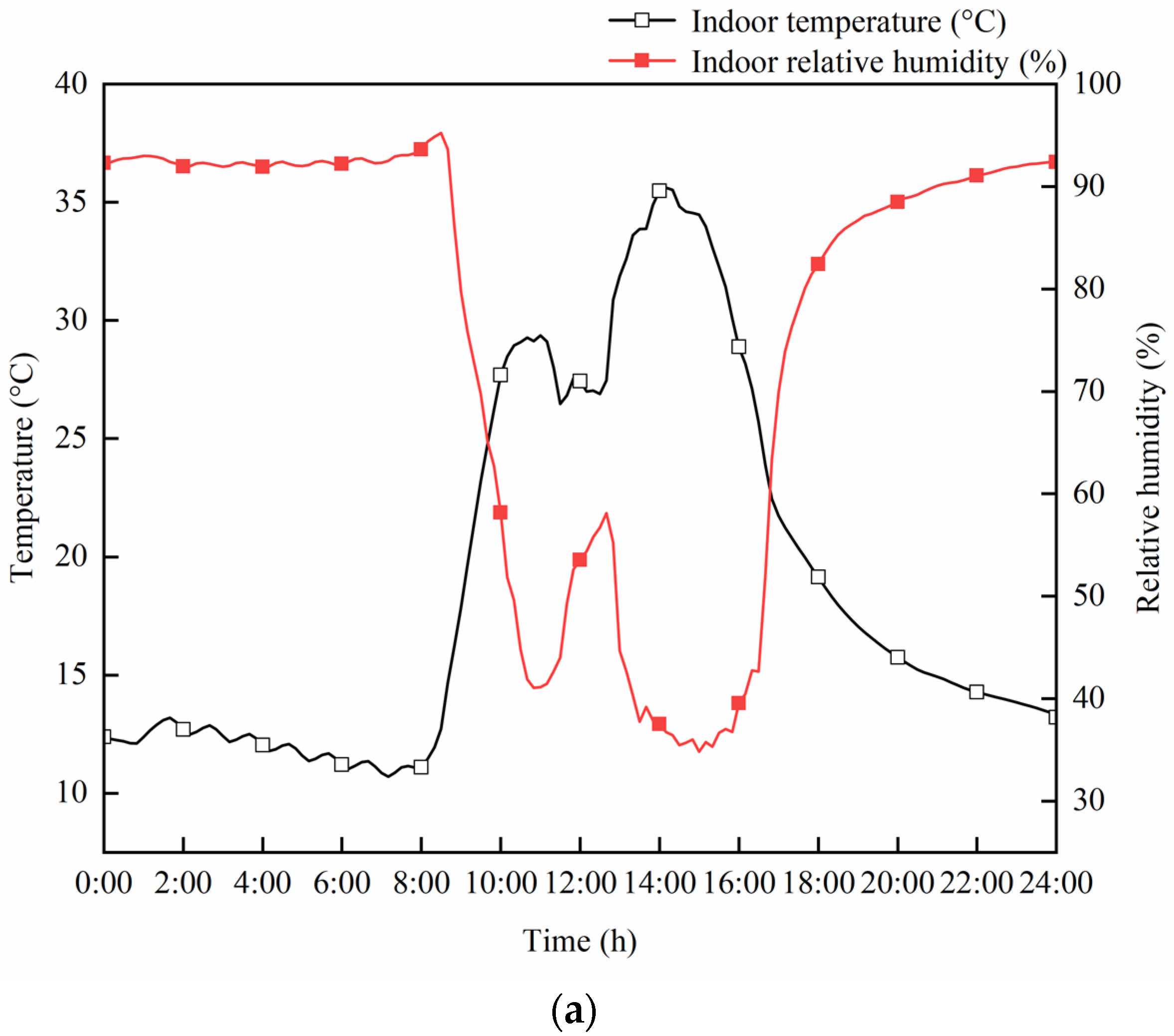
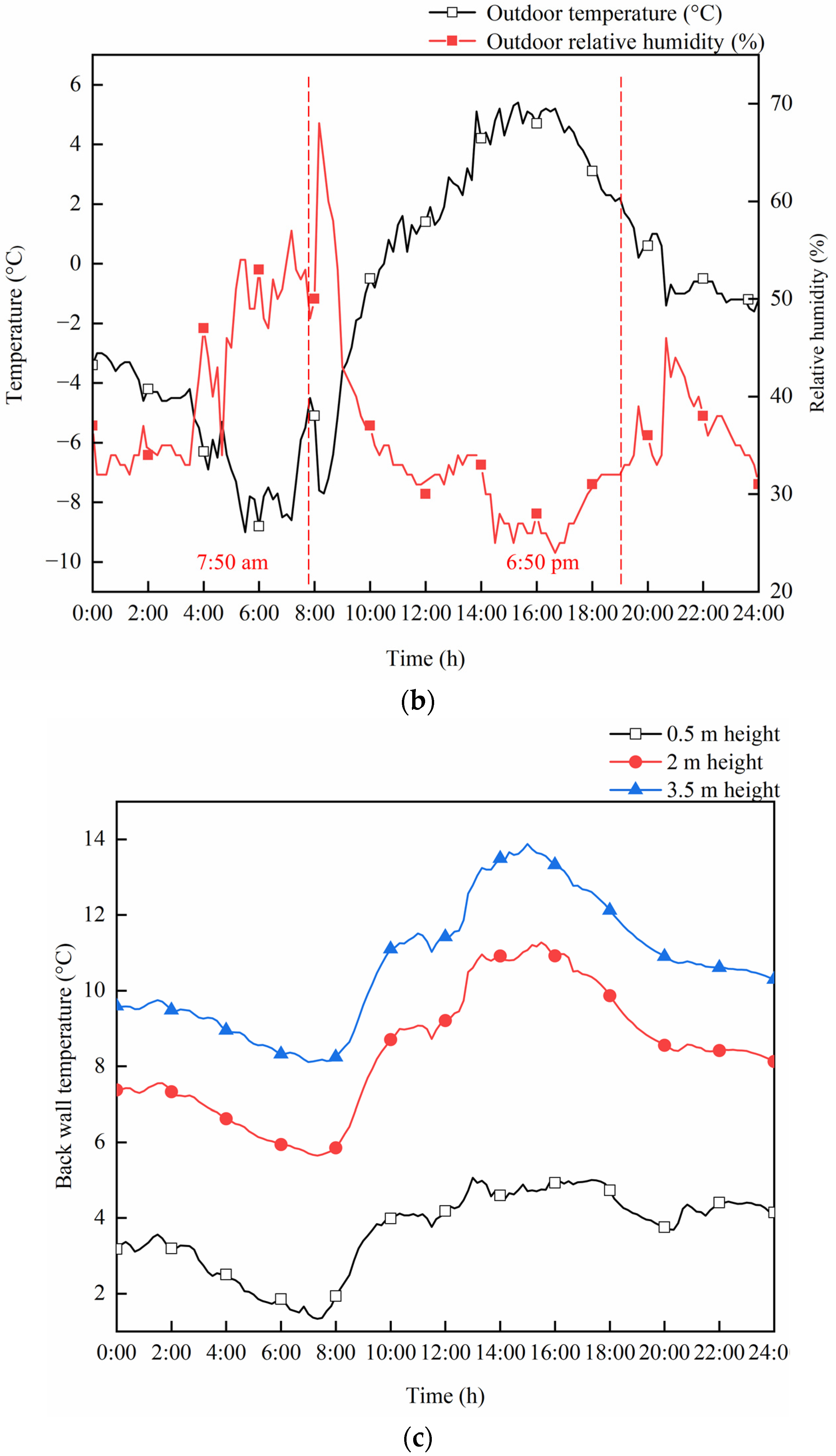

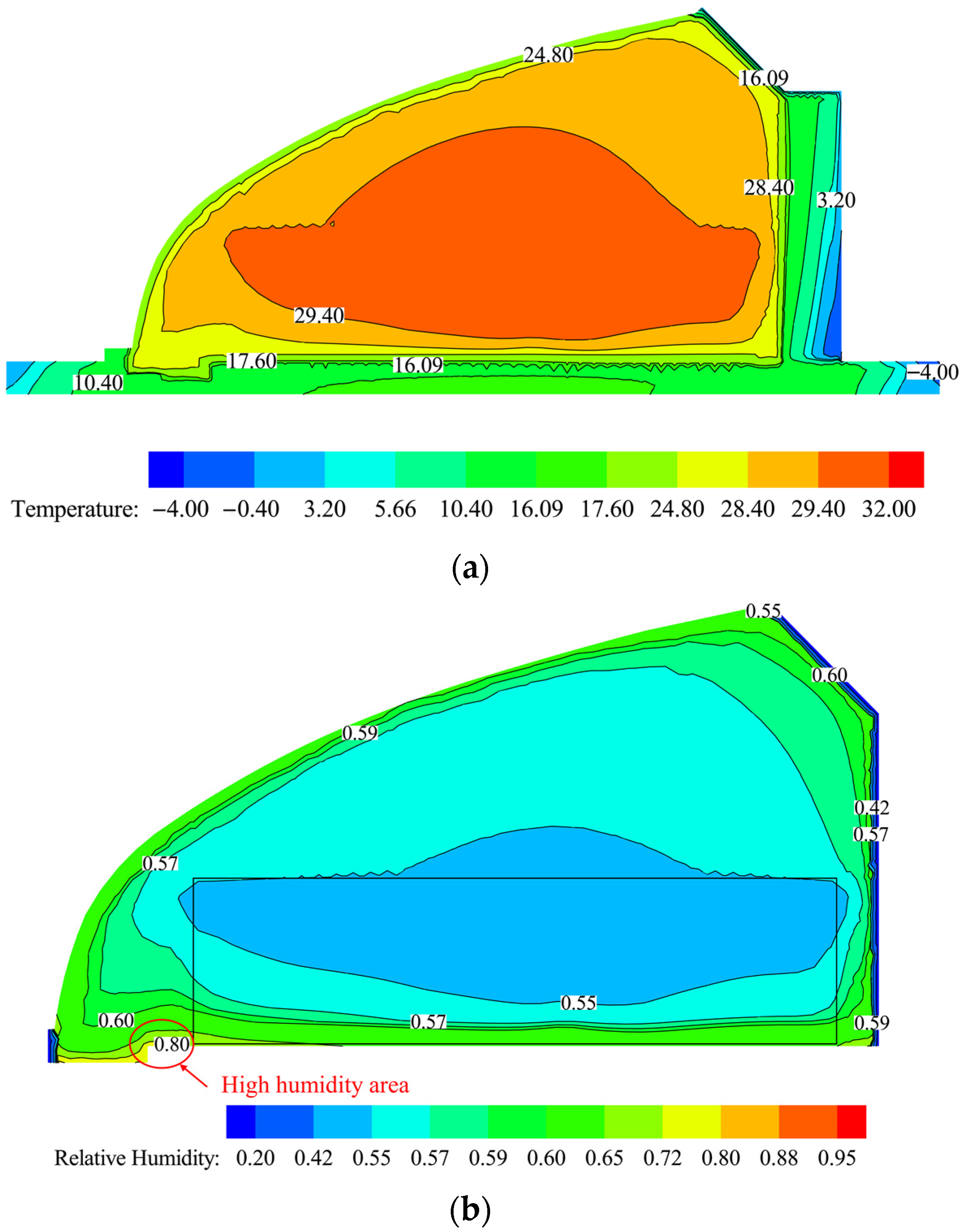

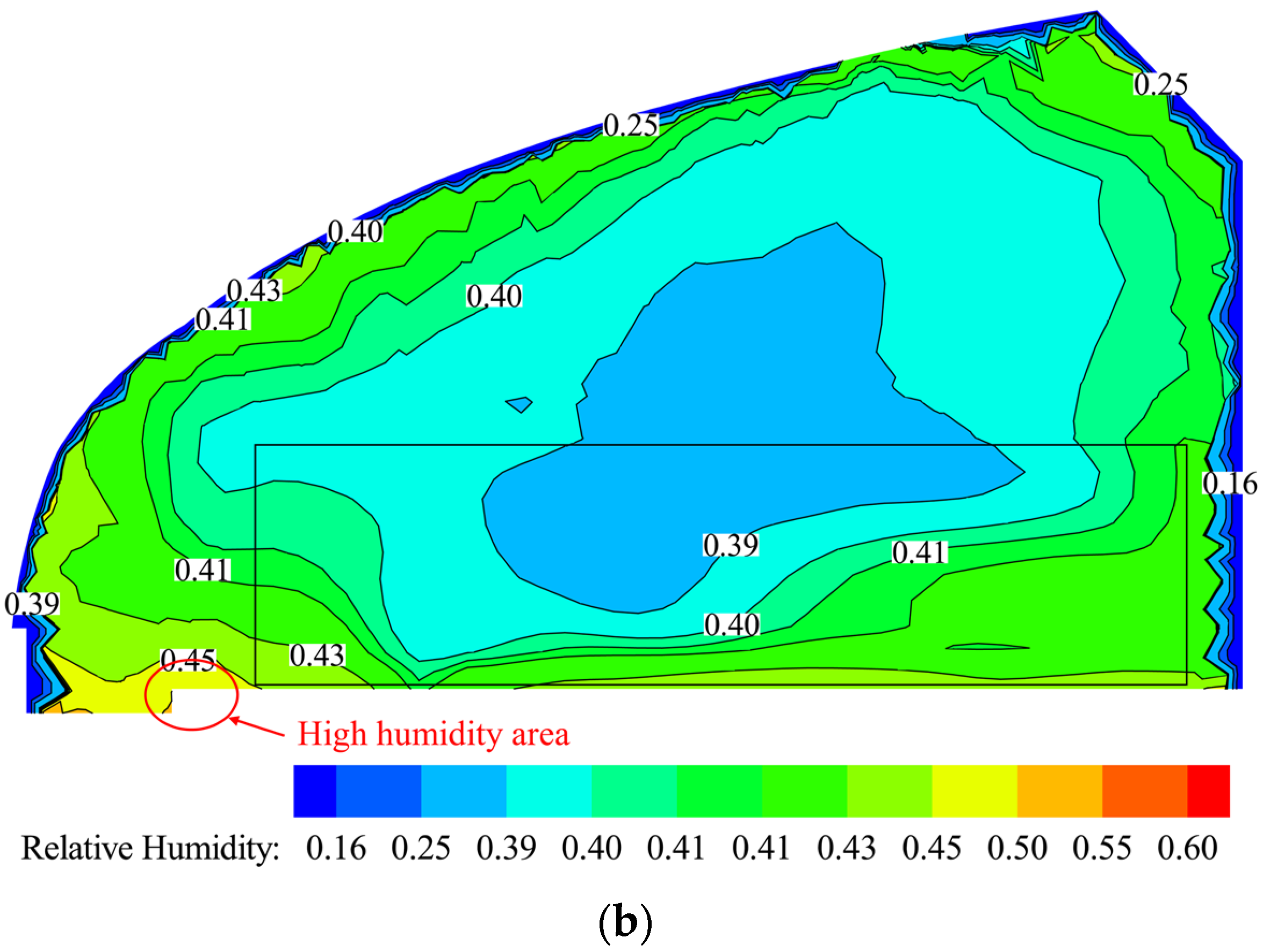
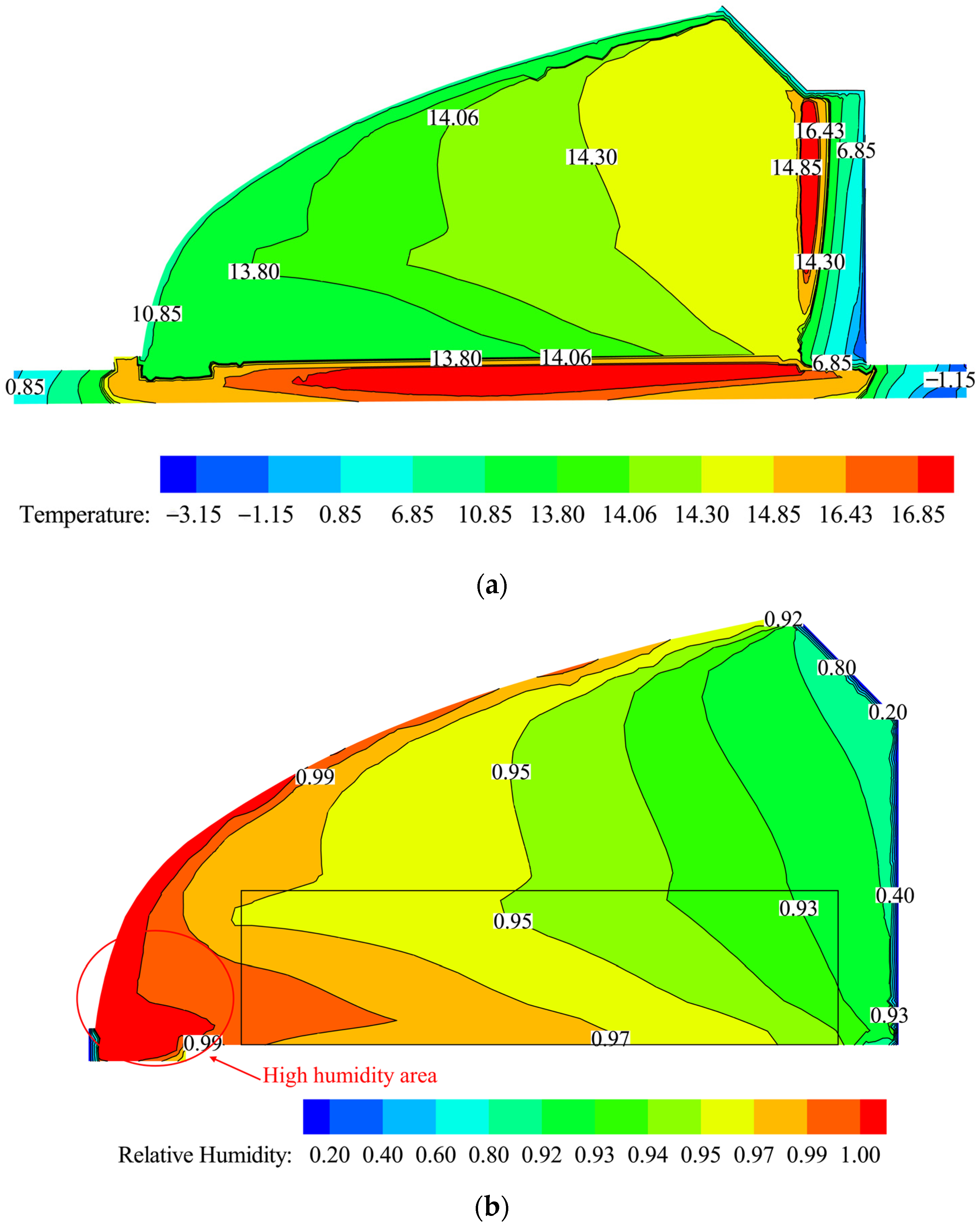
| Parameters | PO Film | Gable | Soil | Tomato Crop | Extruded Polystyrene Board | Thermal Insulation | Concrete |
|---|---|---|---|---|---|---|---|
| Density (kg·m−3) | 950 | 1600 | 1600 | 560 | 32 | 150 | 2300 |
| Specific heat (J·kg−1·K−1) | 1600 | 1050 | 2200 | 2100 | 1500 | 1880 | 920 |
| Coefficient of thermal conductivity (W·m−1·K−1) | 0.19 | 1.432 | 0.80 | 0.19 | 0.028 | 0.06 | 1.51 |
| Absorption coefficient (m−1) | 0.15 | 0.8 | 0.88 | 0.45 | 0.1 | 0.1 | 0.8 |
| Scattering coefficient(m−1) | / | 0.37 | 0.12 | 0.1 | / | / | / |
| Refractive index | 1.70 | 1.47 | 1.92 | 2.77 | 1.7 | 1.7 | 1.47 |
| Emissivity | 0.85 | 0.85 | 0.92 | 0.95 | 0.8 | 0.8 | 0.85 |
| Working Conditions | Soil Temperature | Back Wall Temperature | Air Temperature | Air Relative Humidity | ||||
|---|---|---|---|---|---|---|---|---|
| RMSE | MAE | RMSE | MAE | RMSE | MAE | RMSE | MAE | |
| G1 | 1.22 °C | 0.66 °C | 1.54 °C | 0.96 °C | 1.69 °C | 1.34 °C | 5.66% | 4.65% |
| G2 | 2.45 °C | 1.50 °C | 2.28 °C | 1.59 °C | 2.53 °C | 2.17 °C | 4.78% | 4.33% |
| G3 | 0.66 °C | 0.46 °C | 1.35 °C | 0.95 °C | 0.15 °C | 0.11 °C | 3.97% | 3.68% |
| Working Conditions | X1 | X2 | X3 | X4 | X5 | X6 | |
|---|---|---|---|---|---|---|---|
| G1 | Indoor air temperature | 0.611 ** | 0.724 ** | 0.858 ** | 0.759 ** | 0.747 ** | 0.785 ** |
| Indoor air relative humidity | −0.352 | −0.596 ** | −0.573 ** | −0.552 ** | −0.599 ** | −0.635 ** | |
| G2 | Indoor air temperature | 0.098 | 0.580 ** | 0.580 ** | −0.748 ** | −0.3 | 0.523 * |
| Indoor air relative humidity | 0.601 ** | 0.054 | 0.089 | 0.604 ** | −0.386 | −0.920 ** | |
| G3 | Indoor air temperature | 0.849 ** | 0.978 ** | 0.886 ** | 0.914 ** | 0.984 ** | 0.987 ** |
| Indoor air relative humidity | −0.623 ** | −0.842 ** | −0.688 ** | −0.731 ** | −0.830 ** | −0.832 ** |
Disclaimer/Publisher’s Note: The statements, opinions and data contained in all publications are solely those of the individual author(s) and contributor(s) and not of MDPI and/or the editor(s). MDPI and/or the editor(s) disclaim responsibility for any injury to people or property resulting from any ideas, methods, instructions or products referred to in the content. |
© 2023 by the authors. Licensee MDPI, Basel, Switzerland. This article is an open access article distributed under the terms and conditions of the Creative Commons Attribution (CC BY) license (https://creativecommons.org/licenses/by/4.0/).
Share and Cite
Si, C.; Qi, F.; Ding, X.; He, F.; Gao, Z.; Feng, Q.; Zheng, L. CFD Analysis of Solar Greenhouse Thermal and Humidity Environment Considering Soil–Crop–Back Wall Interactions. Energies 2023, 16, 2305. https://doi.org/10.3390/en16052305
Si C, Qi F, Ding X, He F, Gao Z, Feng Q, Zheng L. CFD Analysis of Solar Greenhouse Thermal and Humidity Environment Considering Soil–Crop–Back Wall Interactions. Energies. 2023; 16(5):2305. https://doi.org/10.3390/en16052305
Chicago/Turabian StyleSi, Changqing, Fei Qi, Xiaoming Ding, Fen He, Zhenjun Gao, Qian Feng, and Liang Zheng. 2023. "CFD Analysis of Solar Greenhouse Thermal and Humidity Environment Considering Soil–Crop–Back Wall Interactions" Energies 16, no. 5: 2305. https://doi.org/10.3390/en16052305





